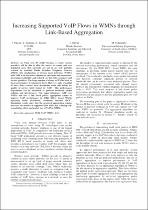JavaScript is disabled for your browser. Some features of this site may not work without it.
- ResearchSpace
- →
- Research Publications/Outputs
- →
- Conference Publications
- →
- View Item
| dc.contributor.author |
Olwal, T

|
|
| dc.contributor.author |
Okech, J

|
|
| dc.contributor.author |
Hamam, Y

|
|
| dc.contributor.author |
Kurien, A

|
|
| dc.contributor.author |
Odhiambo, M

|
|
| dc.date.accessioned | 2008-11-05T10:35:00Z | |
| dc.date.available | 2008-11-05T10:35:00Z | |
| dc.date.issued | 2008-10 | |
| dc.identifier.citation | Olwal, T, Okech, V et al. 2008. Increasing supported VoIP flows in WMNs through link-based aggregation. 2nd IFIP International Symposium on Wireless Communications and Information Technology in Developing Countries, October 2008, pp 7 | en |
| dc.identifier.isbn | 978-84-612-5570-2 | |
| dc.identifier.uri | http://hdl.handle.net/10204/2509 | |
| dc.description | 2008: 2nd IFIP International Symposium on Wireless Communications and Information Technology in Developing Countries | en |
| dc.description.abstract | As Voice over IP (VoIP) becomes a reality, service providers will be able to offer the service to remote and over populated areas that currently are not or are only partially reached by available Public Switched Telephone Network (PSTN). The combination of wireless mesh networks (WMNs) with VoIP is an attractive solution for enterprise infrastructures; presenting availability and reduced cost for both consumers and service providers. The large number of clients in WMNs leads to increased number of concurrent flows. However, only a handful of these flows reaches their destination while still within the quality of service (QoS) bound for VoIP. This performance degradation can be attributed to protocol overhead, packet collision and interferences. This paper introduces VoIP over WMNs and uses a link based packet aggregation scheme to improve VoIP performance in IEEE 802.11 based WMNs operating under distributed coordinate function (DCF). Simulation results show that the proposed aggregation scheme increases the number of supported flow while also reducing end-to-end delay, jitter, and packet loss of VoIP in WMNs | en |
| dc.language.iso | en | en |
| dc.publisher | IFIP International Symposium on Wireless Communications and Information Technology in Developing Countries | en |
| dc.subject | SNIR | en |
| dc.subject | VoIP | en |
| dc.subject | WMNs | en |
| dc.subject | QoS | en |
| dc.subject | 2nd IFIP International Symposium on Wireless Communications and Information Technology in Developing Countries | en |
| dc.title | Increasing supported VoIP flows in WMNs through link-based aggregation | en |
| dc.type | Conference Presentation | en |
| dc.identifier.apacitation | Olwal, T., Okech, J., Hamam, Y., Kurien, A., & Odhiambo, M. (2008). Increasing supported VoIP flows in WMNs through link-based aggregation. IFIP International Symposium on Wireless Communications and Information Technology in Developing Countries. http://hdl.handle.net/10204/2509 | en_ZA |
| dc.identifier.chicagocitation | Olwal, T, J Okech, Y Hamam, A Kurien, and M Odhiambo. "Increasing supported VoIP flows in WMNs through link-based aggregation." (2008): http://hdl.handle.net/10204/2509 | en_ZA |
| dc.identifier.vancouvercitation | Olwal T, Okech J, Hamam Y, Kurien A, Odhiambo M, Increasing supported VoIP flows in WMNs through link-based aggregation; IFIP International Symposium on Wireless Communications and Information Technology in Developing Countries; 2008. http://hdl.handle.net/10204/2509 . | en_ZA |
| dc.identifier.ris | TY - Conference Presentation AU - Olwal, T AU - Okech, J AU - Hamam, Y AU - Kurien, A AU - Odhiambo, M AB - As Voice over IP (VoIP) becomes a reality, service providers will be able to offer the service to remote and over populated areas that currently are not or are only partially reached by available Public Switched Telephone Network (PSTN). The combination of wireless mesh networks (WMNs) with VoIP is an attractive solution for enterprise infrastructures; presenting availability and reduced cost for both consumers and service providers. The large number of clients in WMNs leads to increased number of concurrent flows. However, only a handful of these flows reaches their destination while still within the quality of service (QoS) bound for VoIP. This performance degradation can be attributed to protocol overhead, packet collision and interferences. This paper introduces VoIP over WMNs and uses a link based packet aggregation scheme to improve VoIP performance in IEEE 802.11 based WMNs operating under distributed coordinate function (DCF). Simulation results show that the proposed aggregation scheme increases the number of supported flow while also reducing end-to-end delay, jitter, and packet loss of VoIP in WMNs DA - 2008-10 DB - ResearchSpace DP - CSIR KW - SNIR KW - VoIP KW - WMNs KW - QoS KW - 2nd IFIP International Symposium on Wireless Communications and Information Technology in Developing Countries LK - https://researchspace.csir.co.za PY - 2008 SM - 978-84-612-5570-2 T1 - Increasing supported VoIP flows in WMNs through link-based aggregation TI - Increasing supported VoIP flows in WMNs through link-based aggregation UR - http://hdl.handle.net/10204/2509 ER - | en_ZA |






